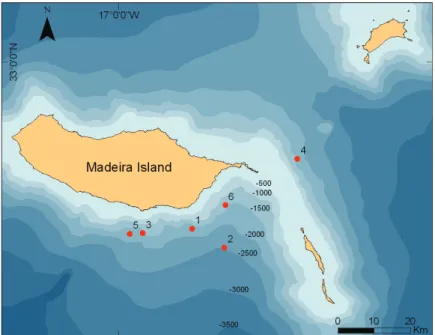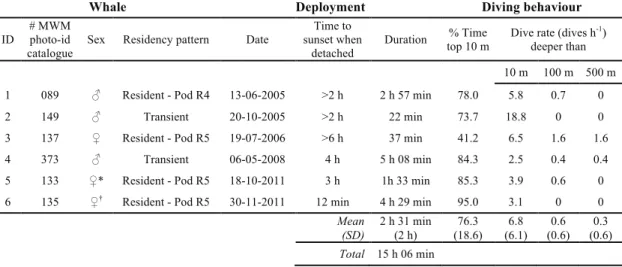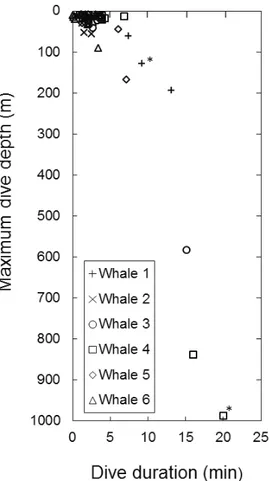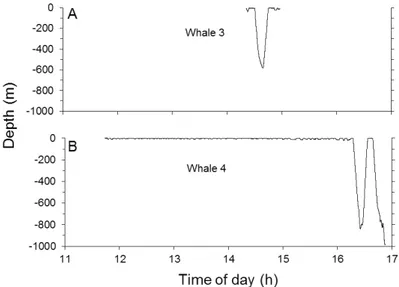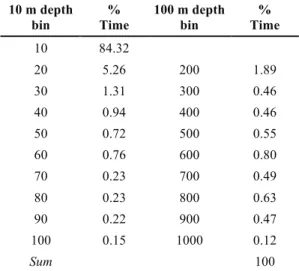Arquipelago - Life and Marine Sciences ISSN: 0873-4704
Daytime dive characteristics from six short-finned pilot
whales Globicephala macrorhynchus off Madeira Island
F
ILIPEA
LVES, A
.D
INIS, C
.R
IBEIRO, C
.N
ICOLAU, M
.K
AUFMANN, C
.M. F
ORTUNA& L
.F
REITASAlves, F., A. Dinis, C. Ribeiro, C. Nicolau, M. Kaufmann, C.M. Fortuna & L. Freitas 2013. Daytime dive characteristics from six short-finned pilot whales Globicephala macrorhynchus off Madeira Island. Arquipelago. Life and Marine Sciences 31: 1-8.
Six time-depth recorders attached with suction-cups were deployed in resident and transient adult short-finned pilot whales to evaluate their daytime diving characteristics in their preferred habitat area off Madeira Island. Here, data on the proportion of time spent at the surface and at different dive phases (descent, bottom and ascent), dive depths and dive rates are presented. With mean attachment durations of 2 h 31 min (SD=2 h), the whales spent a considerable amount of time at the surface (mean=76.3%, SD=18.6) and presented a low diving rate (mean=6.8 dives h-1, SD=6.1; considering dive as submergence deeper than 10 m). The maximum dive depth recorded in this study was 988 m, and dives deeper than 500 m, which were recorded from resident and transient whales, suggest foraging activity along their preferred habitat area. The analysis of dives deeper than 100 m shows that the percentage of time spent on descent, bottom or ascent varied between dives, with means of ~40, 30 and 30%, respectively.
Key words: biologgers, dive profile, marine mammal, NE Atlantic, TDRs
Filipe Alves1,2,3 (email: filipealves@museudabaleia.org), Ana Dinis1,2,3, Cláudia Ribeiro1,3,
Cátia Nicolau1, Luís Freitas1,3, 1Madeira Whale Museum, PT-9200-031 Caniçal, Portugal;
Manfred Kaufmann2,3, 2University of Madeira, Centre of Life Sciences, Marine Biology
Sta-tion of Funchal, PT-9000-107 Funchal, Portugal; 3CIIMAR/CIMAR - Interdisciplinary
Centre of Marine and Environmental Research, University of Porto, Rua dos Bragas 289, PT-4050-123 Porto, Portugal; Caterina M. Fortuna, Italian National Institute for Envi-ronmental Protection and Research, via Vitaliano Brancati 60, IT‐00144 Rome, Italy.
INTRODUCTION
Obtaining information on the diving behaviour of marine mammals is of major interest for management purposes (Hooker & Baird 2001). When combined with knowledge on group behaviour, the percentage of time a species spends at the surface can help converting the at-surface abundance to total estimates of abun-dance, as this adjusts for whales that are not detected at the surface during visual surveys (La-ake & Borchers 2004). On the other hand, infor-mation on the subsurface dive profile is important
1999) or in assessment of depth-specific impacts (e.g. acoustic; Hooker & Baird 2001).
Short-finned pilot whales, Globicephala macrorhynchus Gray, 1846, are top predators inhabiting circum-tropical and warm temperate waters. Several aspects of this species diving behaviour have been documented, such that foraging dives seem to adapt to circadian rhythms, with deeper dives and longer periods of time shallow diving or surface resting occurring during the day (Baird et al. 2003; Soto et al. 2008). Yet, time-per-depth data for this species has only been addressed by Wells et al. (2013),
Alves et al.
linked telemetry of two adult males released directly from a mass stranding. Moreover, the proportion of each dive spent at the bottom has only been described for the related long-finned pilot whale G. melas (Baird et al. 2002; Heide-Jørgensen et al. 2002).
In Madeira Archipelago (NE Atlantic) short-finned pilot whales demonstrate a large degree of variability in site fidelity (Alves et al. 2013). It is suggested that transient and resident whales inter-act for mating purposes when they meet (Alves et al. 2013), and that there is a preference for these whales to use the southern and eastern waters of Madeira Island (Filipe Alves, unpublished data from the Madeira Whale Museum). In this study, and for the first time in Madeira, biologgers were used in short-finned pilot whales to evaluate their daytime diving characteristics. Six time-depth recorders (TDRs) attached with suction-cups were deployed in resident and transient adult whales in their preferred habitat area. Here, we present data on the proportion of time spent at the surface and at different dive phases (descent, bottom and ascent), dive depths and dive rates.
MATERIAL AND METHODS
Fieldwork was undertaken from the 18 m research yacht ZIPHIUS or from the 6.5 m inflatable boat ROAZ, from 2005 to 2011, along the south and east coast of Madeira Island (Fig. 1). Tags technical specificities, deployment pro-cedures, and data download are described in Alves et al. (2010). TDRs were set to sample depth once per second, to a maximum of 2000 m. At each tag deployment, the reaction of the animal was recorded, as well as the presence of calves, group size, animal’s behaviour, GPS posi-tion and travel direcposi-tion. To minimize disturbance and record more natural behaviours, the boat left the group approximately 10 min after each de-ployment. During tag deployment, each tagged whale was digitally photographed for dorsal fin comparison to 683 individuals recorded between 2001 and 2011 and catalogued in a photo-identification database held at the Madeira Whale Museum.
Fig. 1. Bathymetric map showing the location of the six deployments used in this study, archipelago of Madeira, Portugal. Numbers 1-6 correspond to whales ID. Depth in metres.
G. macrorhynchus dive patterns off Madeira
This allowed assignment of a residency pattern and a pod affiliation (in the case of resident whales) according to Alves et al. (2013). The photographs, together with field observations, allowed categorising all tagged whales as adults, and classifying their sex according to descriptions by Yonekura et al. (1980) and Kasuya & Marsh (1984).
A dive was defined as submergence deeper than 10 m (about two body lengths) to exclude brief shallow submersions between respirations. The proportion of time spent at the top 10 m layer and the diving rate (number of dives h-1) were determined for each whale. The mean proportion of time spent at the top 10 m and the mean diving rate were calculated per component (sex, resi-dency pattern and resident pod); however the lim-ited number of samples did not allow a robust analysis. Additionally, the total proportion of time spent at different depth bins was determined. To characterise the proportion of time spent at each phase in dives deeper than 100 m, we defined: ‘descent’ as the time between the begin-ning of the dive, from the surface, to the bottom; ‘bottom’ as the time between the point character-ised by an inversion of the vertical direction in the last ⅔ of maximum depth and/or followed by a stabilisation of depth, and the point when ascent
begins at constant rate; and ‘ascent’ as the time between the end of bottom and surface.
A variety of depths (e.g. >100, >300, >500 m) are described in literature for establishing deep foraging dives in short-finned pilot whales (Baird et al. 2003; Soto et al. 2008; Jensen et al. 2011). We tried to establish it by searching for a bimodal distribution on a plot of the duration and maximum depth of dives (following Hooker & Baird 2001). Two sets of dives longer and deeper than the majority of dives were found: one between 100 and 200 m, and other deeper than 500 m (Fig. 2). Therefore, instead of establishing one depth defining deep dives, the dive statistics were analysed for these categories.
RESULTS
Six tag deployments (out of 18 attempts) yielded 15 h 06 min of data, and attachment durations ranged from 22 min to 5 h 08 min, with a mean of 2 h 31 min (SD=2 h) (Table 1). Tag recordings occurred between 11:44 and 18:49 local time, i.e. before sunset independently of the sampling season. Tags were applied to four residents (three females from the same pod and one male from a different pod) and two male transients (Table 1). Table 1. Summary of the tags deployed on adult short-finned pilot whales, including diving behaviour; MWM - Madeira Whale Museum; *With calf; †Sex confirmed by genetic analysis from a biopsy collected in another encounter (Alves et al. 2013). Residency pattern and pod ID according to Alves et al. (2013).
Whale Deployment Diving behaviour
ID # MWM photo-id
catalogue Sex Residency pattern Date
Time to sunset when
detached Duration
% Time
top 10 m Dive rate (dives h -1) deeper than 10 m 100 m 500 m
1 089 ♂ Resident - Pod R4 13-06-2005 >2 h 2 h 57 min 78.0 5.8 0.7 0
2 149 ♂ Transient 20-10-2005 >2 h 22 min 73.7 18.8 0 0
3 137 ♀ Resident - Pod R5 19-07-2006 >6 h 37 min 41.2 6.5 1.6 1.6
4 373 ♂ Transient 06-05-2008 4 h 5 h 08 min 84.3 2.5 0.4 0.4
5 133 ♀* Resident - Pod R5 18-10-2011 3 h 1h 33 min 85.3 3.9 0.6 0
6 135 ♀† Resident - Pod R5 30-11-2011 12 min 4 h 29 min 95.0 3.1 0 0
Mean
(SD) 2 h 31 min (2 h) (18.6) 76.3 (6.1) 6.8 (0.6) 0.6 (0.6) 0.3
Alves et al.
The water depth during deployments ranged from 1000 to 2500 m (Fig. 1). Tagging caused only short-term (few seconds) reactions to tagged animals, such as sudden shallow dive or tail slap-ping. These animals then rejoined the group and regained their natural behaviour. A visual inspec-tion of the dive profiles showed no discrepancies during the first minutes (Fig. 3 and 4), thus these were not excluded from the data analysis.
Fig. 2. Dive duration and maximum dive depth for 59 dives deeper than 10 m recorded from six adult short-finned pilot whales. * Estimated values since tag de-tached during beginning of ascent; using the mean ascent rate of the previous (similar) dive of the same whale. Two dives were not considered since tag detached during descent. Three dives between 100 and 200 m and three deeper than 500 m differentiate from the majority of dives, which were shallower than 100 m
The dive profiles in relation to time of day showed periods of surfacing and shallow diving (shallower than 100 m) intercalated with periods of dives between 100 and 200 m (whales 1, 2, 5 and 6; Fig. 3), and with periods of dives between 500 and 1000 m (whales 3 and 4; Fig. 4). With the exception of one animal (whale 3), the percentage of time each tagged whale spent in the top 10 m was >73%, with an overall mean of 76.3% (SD=18.6) (Table 1). Similar values were obtained between all components (sex, residency pattern and pod affiliation; Table 2).
Table 2. Mean of the percentage of time spent in the top 10 m and of the dive rate deeper than 10 m per sex, per residency pattern and per resident pod.
Component top 10 m % Time (dives hDive rate -1)
Male 78.7 (SD=5.3, n=3) (SD=8.3, n=3) 9.0 Female 73.8 (SD=28.7, n=3) (SD=1.8, n=3) 4.5 Resident 74.9 (SD=23.5, n=4) (SD=1.6, n=4) 4.8 Transient 79.0 (SD=7.5, n=2) (SD=11.5, n=2) 10.7 Male-Resident 78.0 (n=1) (n=1) 5.8 Male-Transient 79.0 (SD=7.5, n=2) (SD=11.5, n=2) 10.7 Female-Resident 73.8 (SD=28.7, n=3) (SD=1.8, n=3) 4.5 Pod R4 78.0 (n=1) (n=1) 5.8 Pod R5 73.8 (SD=28.7, n=3) (SD=1.8, n=3) 4.5
Whales performed a total of 61 dives deeper than 10 m, of which three were between 100 and 200 m, and three were deeper than 500 m, presenting mean dive rates of 6.8 (SD=6.1), 0.6 (SD=0.6) and 0.3 (SD=0.6) dives h-1, respectively (Table 1). Transient males presented a considerably higher number of dives (Table 2). The analysis of the total proportion of time from the six tagged whales per depth bin shows that 94.1% of the time was spent in the 100 m bin, of which most was spent in the shallower bins (84.3% in the top 10 m, Table 3). The whales then spent 1.89% of their time in the 200 m bin (i.e. between 101 and 200 m), followed by the 600 m bin (0.80%) and
G. macrorhynchus dive patterns off Madeira
Fig. 3. Dive profiles in relation to local time of day for whales 1 (A), 2, 5 (B) and 6 (C). The last dive of whales 1, 2 and 6 is incomplete due to tag detachment at depth. Dive profiles show periods of surfacing and shallow diving intercalated with dives to almost 200 m.
Fig. 4. Dive profiles in relation to local time of day for whales 3 (A) and 4 (B). The last dive of whale 4 is incomplete due to tag detachment at depth. Dive profiles show periods
Alves et al.
Table 3. Total percentage of time spent by six tagged whales at each depth bin. The depth bin ‘10’ covers the top 10 m, the bin ‘20’ covers depths between 11 and 20 m, etc. The depth bin ‘200’ covers depths between 101 and 200 m, etc. The whales spent 94.1% of time in the 100 m depth bin.
10 m depth
bin Time % 100 m depth bin Time %
10 84.32 20 5.26 200 1.89 30 1.31 300 0.46 40 0.94 400 0.46 50 0.72 500 0.55 60 0.76 600 0.80 70 0.23 700 0.49 80 0.23 800 0.63 90 0.22 900 0.47 100 0.15 1000 0.12 Sum 100
Apart from three dives, all dives shallower than 100 m lasted less than 5 min and, as a general trend, deeper dives tended to be longer (Fig. 2). The maximum dive depth recorded was 988 m, based on an incomplete dive (Table 4). The maximum dive depth and duration recorded from a complete dive were 839 m and 16.08 min
(Table 4). The analysis of dives deeper than 100 m shows that the percentage of time spent on descent, bottom or ascent varied between dives, and presented means of ~40, 30 and 30%, respectively (Table 4). Higher mean rates of de-scent and ade-scent were recorded in the dives deeper than 500 m (Table 4).
DISCUSSION
This study shows that six adult short-finned pilot whales tagged during daytime in Madeira spent a considerable amount of time at the surface with a low diving rate. Even not being directly comparable due to using different depth bins, Wells et al. (2013) have shown that two adult short-finned pilot whales tagged in the west Atlantic also spent most of the time at the surface and at shallower depths. Similar findings have also been described for the long-finned pilot whale (Heide-Jørgensen et al. 2002; Nawojchik et al. 2003).
However, and despite the consistency in the results found among whales of different components in our study, a higher number of deployments or of hours of data is required to address the many different parameters that might influence diving behaviour.
Table 4. Dive statistics of daytime dives deeper than 100 m. Dives ranked by maximum depth. aMinimum value since tag detached during beginning of ascent, but the whale could have descended again. bEstimated value (due to incomplete dive) using the mean ascent rate of the previous (similar type and depth) dive of that whale. c Approxi-mate value due to incomplete dive. dV-shaped dive with no defined bottom. eSee definition in M&M.
Whale Maximum Duration % Time at Mean rate (m s-1) of
ID depth (m) (min) descent bottome ascent descent ascent
1 130a 9.32b 50c 25c - 0.4 - 5 170 7.22 56.9 -d 43.1 1.2 1.0 1 196 13.20 30.2 42.5 27.3 0.7 0.8 3 584 15.15 24.2 41.3 34.6 1.9 1.8 4 839 16.08 49.4 18.7 32.0 1.8 2.4 4 988a 20.09b 43c 27c - 1.6 - Mean (SD)
G. macrorhynchus dive patterns off Madeira
Information on the time the animals spent at sur-face can be very helpful in the analysis of visual line-transect surveys assuming the contribution to convert the at-surface abundance to total esti-mates of abundance (Laake & Borchers 2004). However, individual dive behaviour can differ from group diving behaviour, so that information is biased if not combined with information on dive synchrony. While Shane (1995) and we (un-published data) have observed entire pods of short-finned pilot whales submerging during several minutes, acoustic studies have shown an apparent lack of dive synchrony (Jensen et al. 2011; Soto 2006; Soto et al. 2008). Therefore, further information on dive synchrony is needed in order to determine with accuracy the proportion of time whales are ‘detectable’, thus accounting more adequately for the ‘availability bias’ (Laake & Borchers 2004). That information can be acquired with visual behavioural studies, acoustic studies or possibly through tagging of all individuals in a small (3-5 individuals) pod. The dives recorded in this study are likely to represent maximum diving performance for the species given that dive capability is known to generally increase with body size (Schreer & Kovacs 1997) and all the tagged whales were identified as adults, and given that dives were not depth limited. The depths reported here are in agreement with depth ranges described for day-time deep dives of short-finned pilot whales off Tenerife (Soto et al. 2008). Dives deeper than 500 m recorded in this study suggest foraging activity, especially as they are comparable to results in Baird et al. (2002) and Soto et al. (2008). Such deep dives have a high energetic cost and likely enable the animals to get a high-gain in return (Thompson & Fedak 2001), for example feeding on high-caloric prey such as squid which have been described as the primary diet of pilot whales (Desportes & Mouritsen 1993; Mintzer et al. 2008). Therefore, at least three dives, one from a resident (whale 3) in the south and two from a transient (whale 4) in the east of Madeira Island, are assumed to be foraging dives.
The duration of dives in this study is in accordance with values obtained for this species in the western Atlantic (Wells et al. 2013) and
descent and ascent recorded for dives deeper than 500 m are comparable to the values obtained for similar dives of short-finned pilot whales off Tenerife (Soto et al. 2008). Concerning the percentage of time at bottom, the ~30% obtained during five dives deeper than 100 m in this study are within the range of the means presented for its related species (Baird et al. 2002).
The limited number of successful TDR tag deployments during this study may have been caused by difficulties in approaching animals and by a limited number of animals available for tagging. This limited amount of data per disturb-ance discourages further use of these tags, in sub-stitution of the technologically improved satellite-linked TDRs. Yet, attachment durations in this study did not differ much from those described in Baird et al. (2002) and Soto et al. (2008).
ACKNOWLEDGEMENTS
We wish to thank the skippers João Viveiros, Miguel Silva and Hugo Vieira for their dexterity; Ana Higueras, Marianne Böhm-Beck and Jonatan Svensson for field work assistance; Adalberto Carvalho for assistance with the map using ArcGIS 9.3.1; Machico Town Hall and EU pro-grams for co-funding the projects MACETUS (FEDER/INTERREG III-B MAC/4.2/M10), EMECETUS (05/MAC/4.2/M10) and CETA-CEOS MADEIRA II (LIFE+ NAT/P/000646); Cláudia Faustino for the revision of an earlier version of the manuscript; anonymous reviewers for providing helpful comments on the manu-script; and Daniel Webster for training. The ex-periments comply with the current Portuguese laws.
REFERENCES
Alves, F., A. Dinis, I. Cascão & L. Freitas 2010. Bryde’s whale (Balaenoptera brydei) stable associations and dive profiles: new insights into foraging behavior. Marine Mammal Science 26: 202-212.
Alves, F., S. Quérouil, A. Dinis, C. Nicolau, C. Ribeiro, L. Freitas, M. Kaufmann & C. Fortuna 2013. Population structure of short-finned pilot
Alves et al.
implications for conservation. Aquatic
Conservation: Marine and Freshwater Ecosystems
23: 758–776.
Baird, R.W., J.F. Borsani, M.B. Hanson & P.L. Tyack 2002. Diving and night-time behavior of long-finned pilot whales in the Ligurian Sea. Marine
Ecology Progress Series 237: 301-305.
Baird, R.W., D.J. McSweeney, M.R. Heithaus & G.J. Marshall 2003. Short-finned pilot whale diving behavior: deep feeders and day-time socialites. Pp. 10 in: Abstracts of the 15th Biennial Conference on
the Biology of Marine Mammals, Joseph S. Koury
Convention Center, Greensboro, North Carolina, December 2003. 201 pp.
Desportes, G. & R. Mouritsen 1993. Preliminary results on the diet of long-finned pilot whales off the Faroe Islands. Report of the International Whaling
Commission (Special Issue) 14: 305-324.
Heide-Jørgensen, M.P., D. Bloch, E. Stefansson, B. Mikkelsen, L.H. Ofstad & R. Dietz 2002. Diving behaviour of long-finned pilot whales
Globicephala melas around the Faroe Islands. Wildlife Biology 8: 307-311.
Hooker, S.K. & R.W. Baird 2001. Diving and ranging behaviour of odontocetes: a methodological review and critique. Mammal Review 31: 81-105.
Jensen, F.H., J.M. Perez, M. Johnson, N.A. Soto & P.T. Madsen 2011. Calling under pressure: short-finned pilot whales make social calls during deep foraging dives. Proceedings of the Royal Society B 278: 3017-3025.
Kasuya, T. & H. Marsh 1984. Life history and reproductive biology of the short-finned pilot whale, Globicephala macrorhynchus, off the Pacific coast of Japan. Report of the International
Whaling Commission (Special Issue) 6: 259-310.
Laake, J.L. & D.L. Borchers 2004. Methods for
incomplete detection at distance zero. Pp. 108-189
in: Buckland, S.T., D.R. Anderson, K.P. Burnham, J.L. Laake, D.L. Borchers & L. Thomas (Eds).
Advanced distance sampling. Oxford University
Press, Oxford. 416 pp.
Mintzer, V.J., D.P. Gannon, N.B. Barros & A.J. Read 2008. Stomach contents of mass-stranded short-finned pilot whales (Globicephala macrorhynchus)
from North Carolina. Marine Mammal Science 24: 290-302.
Nawojchik, R., D.J.St. Aubin & A. Johnson 2003. Movements and dive behavior of two stranded, rehabilitated long-finned pilot whales (Globicephala melas) in the northwest Atlantic.
Marine Mammal Science 19: 232-239.
Panigada, S., M. Zanardelli, S. Canese & M. Jahoda 1999. How deep can baleen whales dive? Marine
Ecology Progress Series 187: 309-311.
Schreer, J.F. & K.M. Kovacs 1997. Allometry of diving capacity in air-breathing vertebrates.
Canadian Journal of Zoology 75: 339-358.
Shane, S.H. 1995. Relationship between pilot whales and Risso's dolphins at Santa Catalina Island, California, USA. Marine Ecology Progress Series 123: 5-11.
Soto, N.A. 2006. Acoustic and diving behaviour of pilot whales (Globicephala macrorhynchus) and Blainville’s beaked whales (Mesoplodon
densirostris) off the Canary Islands, with
implications for effects of man-made noise and ship strikes. PhD Thesis, La Laguna University, Tenerife.
Soto, N.A., M.P. Johnson, P.T. Madsen, F. Diaz, I. Dominguez, A. Brito & P. Tyack 2008. Cheetahs of the deep sea: deep foraging sprints in short-finned pilot whales off Tenerife (Canary Islands).
Journal of Animal Ecology 77: 936-947.
Thompson, D. & M.A. Fedak 2001. How long should a dive last? A simple model of foraging decisions by breath-hold divers in a patchy environment. Animal
Behaviour 61: 287-296.
Wells, R.S., E.M. Fougeres, A.G. Cooper, R.O. Stevens, M. Brodsky, R. Lingenfelser, C. Dold & D.C. Douglas 2013. Movements and dive patterns of short-finned pilot whales (Globicephala
macrorhynchus) released from a mass stranding in
the Florida Keys. Aquatic Mammals 39: 61-72. Yonekura, M., S. Matsui & T. Kasuya 1980. On the
external characters of Globicephala
macrorhynchus off Taiji, Pacific coast of Japan. Scientific Reports of the Whales Research Institute
32: 67-95.
Received 1 Apr 2013. Accepted 27 Jun 2013, Published online 13 November 2013.
